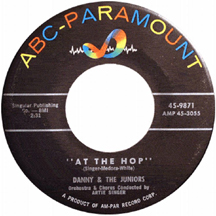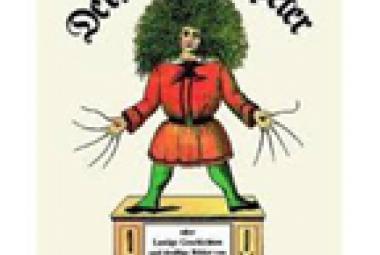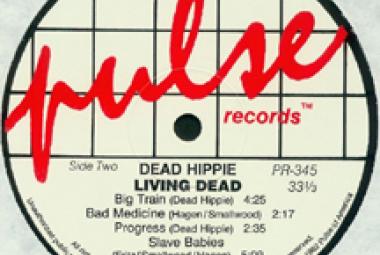AT THE HOP
“At the Hop” is a rock and roll/doo-wop song written by Artie Singer, John Medora, and David White and originally released by Danny & the Juniors. The song was released in the fall of 1957, and reached number one on the US charts on January 6, 1958, thus becoming one of the top-selling singles of 1958. It was also a big hit elsewhere, which included the group enjoying a number 3 placing with the song on the UK charts. The song returned to prominence after it was performed by rock and roll revival act Sha Na Na at the 1969 Woodstock Festival and featured in the 1973 coming-of-age teen drama American Graffiti. Musically, it is notable for combining several of the most popular formulas in 1950s rock ’n’ roll: the twelve-bar blues, boogie-woogie piano, and the 50s progression. (More from Wikipedia)
David White (real name: David White Tricker) comes from a show biz family, performing as a child with his parents in an acrobatic trio called Barry and Brenda and Company. Singing first tenor, White started a doo-wop vocal group called the Juvenaires in 1955 with Danny Rapp (lead singer), Joe “Terry” Terranova (baritone) and Frank Maffei (second tenor). White made contact with another young singer, John Madara (real name: John Medora) who had a hit in 1957 with “Be My Girl” under the name Johnny Madara. The two wrote a song called “Do the Bop” for the Juvenaires and brought it to their vocal coach and record producer Artie Singer. He liked the song and arranged studio time in Philadelphia to record that song and also a ballad that White had written called “Sometimes (When I’m All Alone)”.
At the studio, the Juvenaires were told that they would be singing back-up for John Madara; but as it turned out, his record company turned down the song “Do the Bop”. Artie Singer took the song to Dick Clark, who suggested that they change the name to “At the Hop”, since “bop” was considered old-fashioned by then. (Cyndi Lauper would later revive the term in a completely different context in her 1984 hit song “She Bop”).
The band changed its name to Danny and the Juniors and. after performing as a last-minute substitute on American Bandstand, had a #1 hit for 7 weeks with “At the Hop” (beginning in January 1958, and breaking the record among vocal groups). In a classic example of so-called “payola”, Artie Singer (who also has a writing credit for “At the Hop”) had to sign over one-half of the publishing credits for the song to Dick Clark (Clark sold the rights to the song prior to the Congressional payola hearings in 1960).
The flip side of the hit single “At the Hop” by Danny and the Juniors was the David White song “Sometimes (When I’m All Alone)”; according to Wikipedia (as taken from the article on David White): “‘Sometimes (When I'm All Alone)’ became a favorite of a lot of street corner groups just starting out who later became successful, including the Capris, the Chimes, the Cleftones, the Young Rascals, the Del Satins, the Dovells, the Elegants, the Impalas, the Earls, Randy and the Rainbows, the Tokens, the Vogues, and Vito and the Salutations among others.”
David White wrote another classic song for Danny and the Juniors called “Rock And Roll Is Here To Stay”, the band’s follow-up hit, reaching #19 on the charts. This song has since become a rock and roll standard and was featured in the films Grease and Christine. Danny and the Juniors also released many other songs that are less well known; in all, they have had 9 singles to make the Billboard Hot 100.
* * *
“At the Hop” though has reached almost mythic status, far beyond even the major hit that Danny and the Juniors made of the song. One of the earliest of the rock and roll revival bands, Sha Na Na (with the name taken from among the innumerable nonsense syllables in the classic “Get a Job” by the Silhouettes) performed “At the Hop” at the original 1969 Woodstock festival not long after the group was founded earlier that year. Sha Na Na is perhaps the most unlikely rock band to appear at Woodstock; what’s more, their set immediately preceded that of Jimi Hendrix which included his legendary performance of “The Star Spangled Banner”. “At the Hop” also appears in the Woodstock film and the triple-LP Woodstock soundtrack album.
Sha Na Na has had a long career, including a syndicated television show called Sha Na Na from 1977 to 1981 (roughly 10 years after their appearance at Woodstock). Wikipedia lists dozens of albums in the band’s discography. The gonzo antics of the best known member of the band, Jon “Bowzer” Bauman were probably the key to the band’s (and the show’s) success. Bowzer did not appear at Woodstock but was in Sha Na Na from 1970 to 1983.
* * *
“At the Hop” was also featured in the nostalgic 1973 hit movie American Graffiti, an early film among the credits for both George Lucas (director) and Francis Ford Coppola (producer). Unlike the other rock and roll hits featured in the film (which were by the original artists and were found only in the soundtrack), three songs were performed in the film by another rock and roll revival band, Flash Cadillac & the Continental Kids. “At the Hop”, “Louie Louie” and an original composition by the band called “She’s So Fine” were performed “live” by Flash Cadillac & the Continental Kids (under the name of Herbie and the Heartbeats) in the dance party sequence in the film. “Louie Louie” did not appear on the double-LP soundtrack album, 41 Original Hits from the Soundtrack of American Graffiti, though “At the Hop” and “She’s So Fine” did.
Flash Cadillac & the Continental Kids (now known as Flash Cadillac) are still around, having released five albums; three singles by the group made the Billboard Hot 100.
(August 2015)















